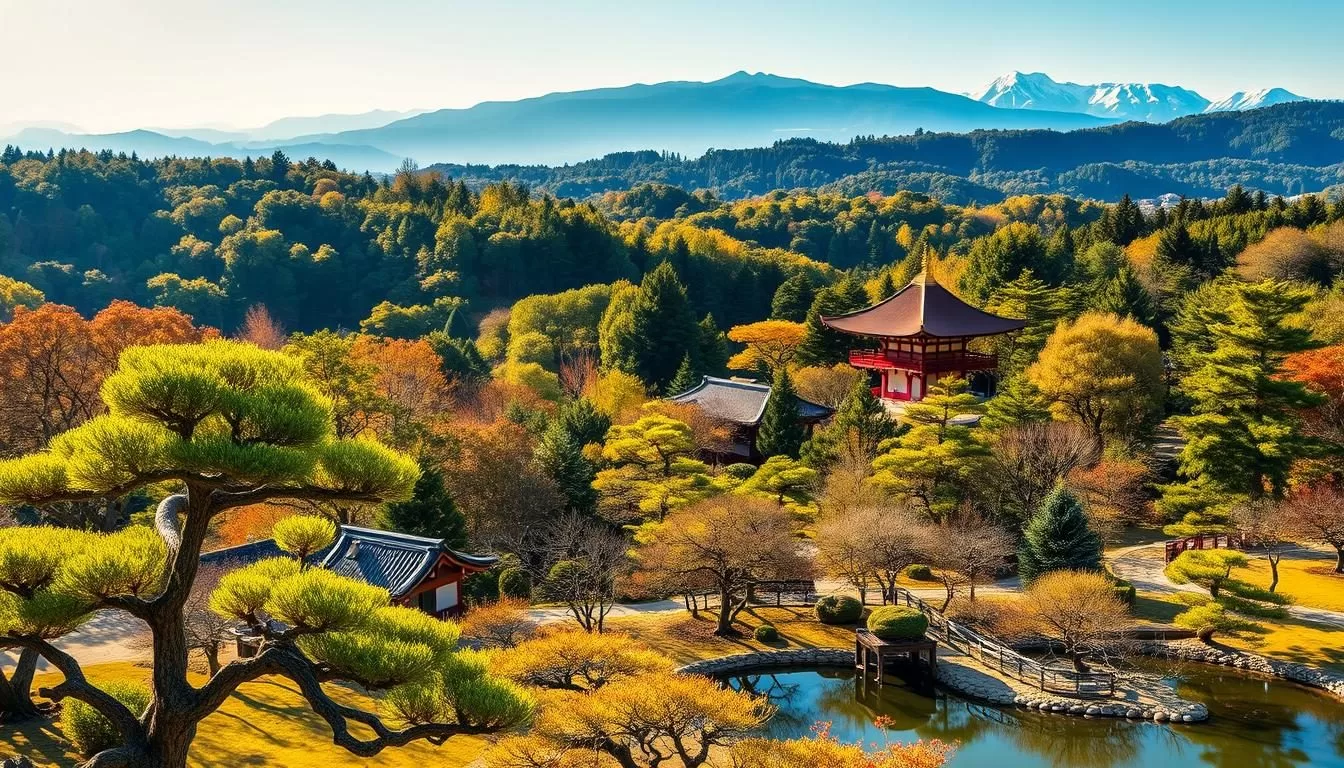✓ Accommodations ✓ Flights ✓ Rental Cars
Are you planning a trip to Nara Prefecture, a historical and cultural gem in Japan? To make the most of your visit, it’s essential to plan around the optimal weather conditions. Nara’s distinct four seasons offer unique experiences, from breathtaking cherry blossoms in spring to vibrant colorful foliage in fall.
This comprehensive guide will help you make informed decisions about the best time to visit based on seasonal events and personal preferences. By understanding Nara’s climate, you’ll be able to enjoy a comfortable and memorable trip. Our guide covers everything from seasonal temperatures to cultural festivals throughout the year, ensuring you’re well-prepared for your adventure.
Understanding Nara’s Climate and Seasons
Nara’s geographic location influences its climate, resulting in diverse seasonal weather patterns. Located in the Kansai region of Japan, Nara experiences a temperate climate with four distinct seasons.
Geographic Location and Climate Influence
Nara is situated in a region known for its varied weather patterns. The city’s climate is influenced by its location in the Nara Basin, which can lead to temperature variations throughout the year. This geographic setting contributes to the overall character of Nara’s weather.
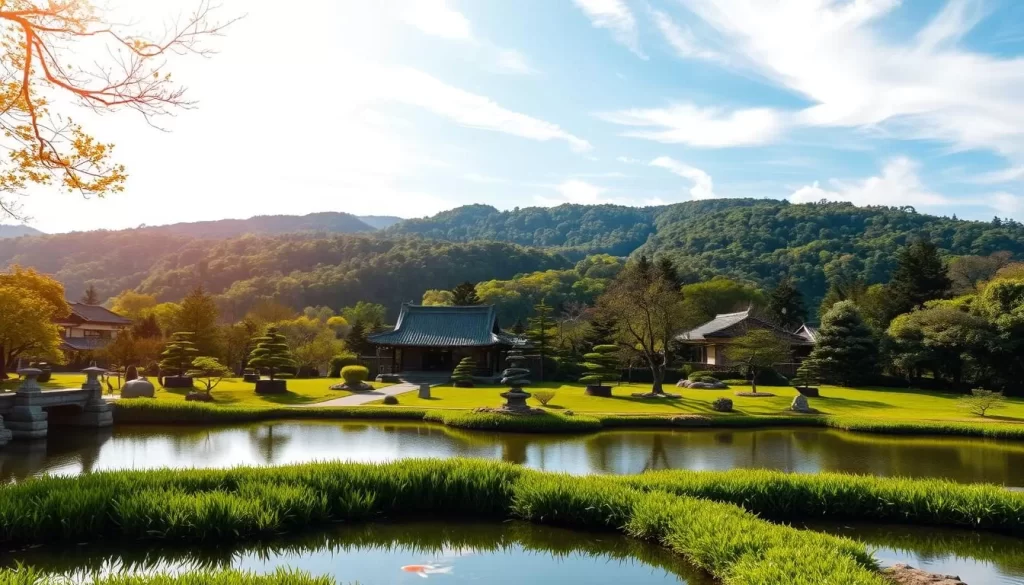
Overview of Seasonal Variations
Nara’s temperature varies significantly across the different seasons. Spring brings mild temperatures, ranging from 60°F to 70°F (15°C to 21°C), while summers are hot, with temperatures between 80°F to 90°F (27°C to 32°C). Autumn cools down to the 60s Fahrenheit (15°C to 21°C), and winters are cold, with temperatures dropping to 40°F to 50°F (4°C to 10°C). Understanding these variations is key to planning your trip at the right time.
Spring in Nara: Cherry Blossom Magic
Spring in Nara is a magical time, marked by the blooming of cherry blossoms and a plethora of cultural celebrations. As you visit Nara during this season, you are treated to a unique blend of natural beauty and rich cultural heritage.
Cherry Blossom Season: Timing and Viewing Spots
Nara’s cherry blossom season typically occurs in late March to early April. Popular viewing spots include Nara Park and Yoshiki-en Garden, where you can witness the stunning beauty of blooming cherry blossoms. These spots are not only beautiful but also steeped in tradition.
Spring Temperatures and Weather Conditions
During spring, Nara’s temperatures range from mild to warm, making it an ideal time to explore the city. You can expect pleasant weather with average highs around 18°C to 22°C (64°F to 72°F).
Cultural Events and Spring Festivals
Spring is a time for cultural celebrations in Nara, with events like the Nara Daibutsu-e and the Higashimuki Spring Festival. The Nara Daibutsu-e at Tōdai-ji temple commemorates the completion of the Great Buddha statue, while the Higashimuki Spring Festival features traditional Japanese performances. These festivals offer a glimpse into Nara’s rich cultural heritage and are a great way to experience the local tradition.
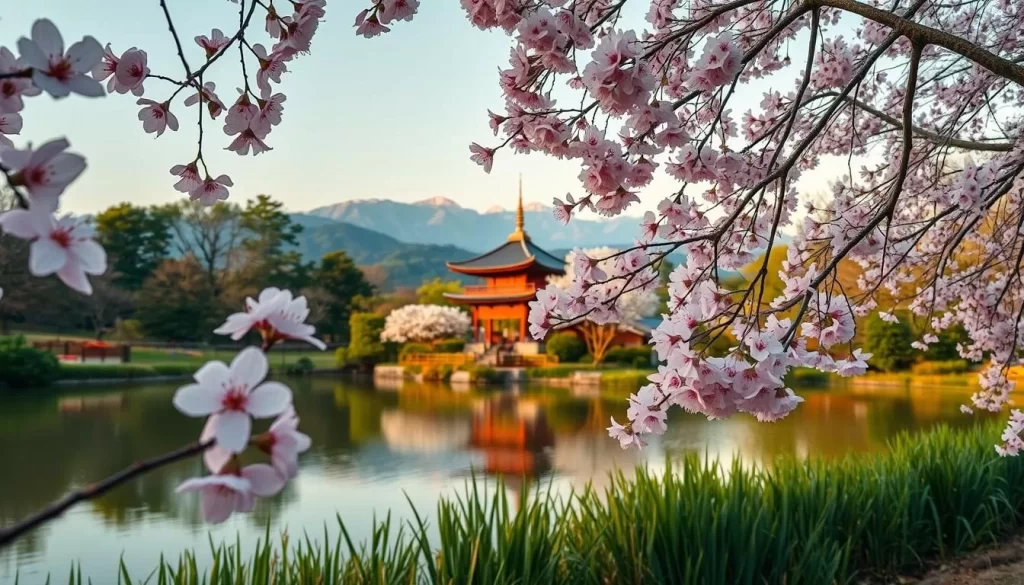
Summer in Nara: Navigating the Heat
Summer is an ideal time to explore Nara’s natural beauty and cultural heritage. The warm weather opens up numerous opportunities for outdoor activities and experiencing the city’s vibrant culture.
Temperature and Humidity Levels
Nara’s summer is characterized by high temperatures and humidity. Daytime temperatures often reach above 30°C (86°F), making it essential to stay hydrated and plan activities accordingly.
Rainy Season Considerations
Summer is also the rainy season in Nara, with occasional downpours. While this can be a challenge, the rain also brings lush greenery to the city, making it a beautiful time for photography and outdoor exploration. Visitors should be prepared with rain gear and flexible plans.
Summer Activities and Attractions
Despite the heat, summer is a great time to enjoy Nara’s outdoors. You can explore the forests, visit peaceful temples, and see deer roaming freely in Nara Park. Other activities include kayaking, biking, and camping. The city’s summer festivals and events offer a glimpse into traditional Japanese culture, while the evening illuminations of historic sites provide a unique and cooler experience.
| Activity | Description | Best Time |
|---|---|---|
| Deer Watching | Early morning deer watching in Nara Park | Early morning |
| Kayaking | Explore Nara’s waterways by kayak | Morning or late afternoon |
| Summer Festivals | Experience traditional Japanese summer festivals | Evening |
Fall in Nara: Autumn Foliage and Mild Weather
Fall in Nara is a season of breathtaking beauty, with mild weather and stunning autumn foliage. The prefecture comes alive with vibrant colors, making it an ideal time to explore its cultural and natural attractions.
Koyo Season: When and Where to See Fall Colors
Nara’s koyo season typically peaks in late November. Popular spots for viewing fall colors include Yoshino Mountain and Nara Park. These locations offer picturesque landscapes that are perfect for photography and leisurely strolls.
Temperature and Weather Patterns
During the fall, Nara experiences comfortable temperatures, ranging from 10°C to 20°C (50°F to 68°F). The weather is generally mild, making it suitable for outdoor activities such as hiking and sightseeing.
Fall Festivals and Cultural Experiences
Nara’s fall is not just about the foliage; it’s also a time for cultural celebrations. The Nara Lantern Festival in September and the Nara Daibutsu-e festival are highlights, showcasing the region’s rich cultural heritage. Visitors can enjoy traditional harvest festivals, seasonal tea ceremonies, and local fall food specialties.
| Festival | Date | Description |
|---|---|---|
| Nara Lantern Festival | September | A magical display of thousands of lanterns |
| Nara Daibutsu-e festival | Fall | Celebration of the Great Buddha statue |
| Shunie fire ceremony | Early spring, but preparations start in fall | A traditional fire ritual |
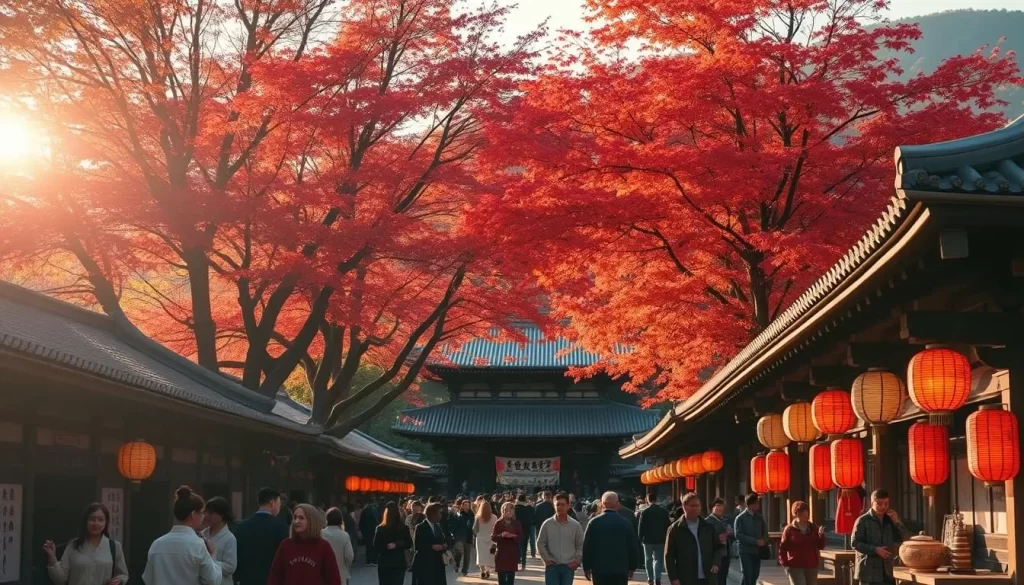
Winter in Nara: Tranquil Beauty and Fewer Crowds
Winter brings a serene beauty to Nara, with fewer crowds and a range of seasonal activities. You can enjoy the city’s historic sites without the hustle and bustle of peak tourist season.
Winter Temperatures and Snowfall Patterns
Nara’s winter is characterized by cool temperatures, with average highs around 10°C (50°F). While snow is not common, occasional snowfall can add a magical touch to the city’s landscapes. You should pack warm clothing to stay comfortable during your visit.
Indoor Attractions and Winter Activities
On chilly days, you can explore Nara’s many indoor attractions, such as museums and temples with indoor facilities. You can also enjoy winter-specific activities like hot spring visits or traditional Japanese tea ceremonies.
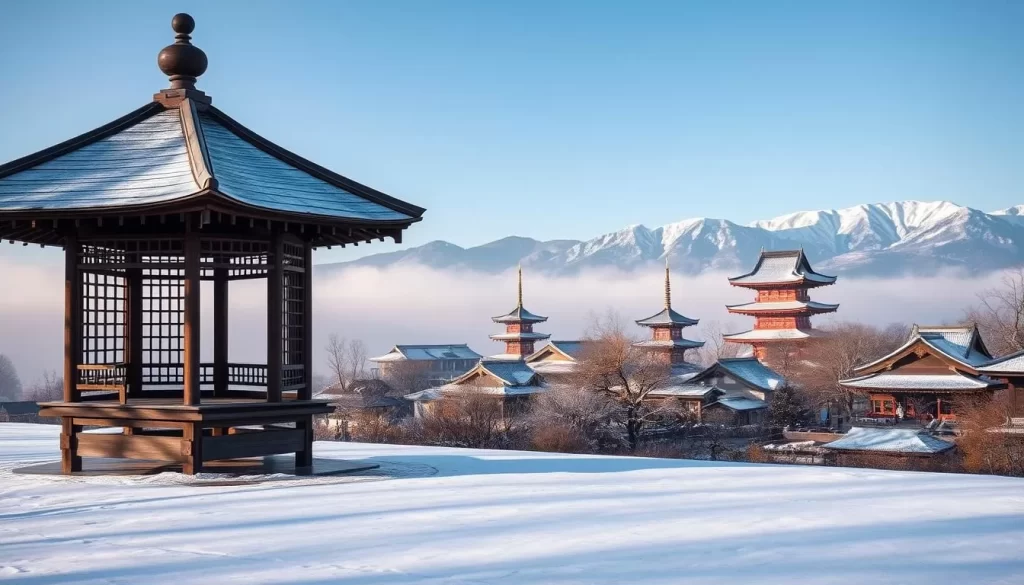
Winter Illuminations and Seasonal Events
Nara’s winter illuminations are a highlight of the season, with many temples and gardens decorated with beautiful light displays. Some key events include:
- The Wakakusa Yamayaki festival in January, a spectacular fire festival on Mount Wakakusa.
- New Year celebrations at Nara’s major temples and shrines, featuring traditional rituals like the ringing of temple bells.
- The early blooming of plum blossoms (ume) in late winter, offering a preview of spring.
You can also enjoy seasonal winter foods and drinks, and take romantic evening walks through Nara’s historic districts, which are beautifully lit during the winter illumination events.
Nara Prefecture, Japan: Best Months for a Weather-Savvy Trip
Nara Prefecture, with its rich history and cultural heritage, is a destination that benefits from weather-savvy planning. Understanding the best times to visit can make a significant difference in your travel experience.
Top Recommendation: Late March to May
The period from late March to May is considered one of the best times to visit Nara. During this time, the weather is mild and pleasant, with temperatures gradually warming up after the cooler spring months. It’s an ideal time to enjoy the cherry blossoms, although the peak bloom usually occurs in late March to early April. Make sure to plan your trip around this time for optimal viewing.
Second Best Option: October to November
For those who prefer autumn, October to November is another excellent period to visit Nara. The fall foliage is stunning, with the changing leaves creating a picturesque landscape. The weather is generally comfortable, with mild temperatures and fewer crowds compared to the peak summer months. This period is perfect for outdoor activities and sightseeing.
Times to Avoid: Golden Week and Peak Summer
There are certain periods that are best avoided when planning your trip to Nara. Golden Week, which typically falls in late April to early May, is a national holiday week in Japan, leading to crowded conditions and higher prices for accommodations and travel. Additionally, peak summer months (July-August) are characterized by extreme heat and humidity, making outdoor exploration challenging. Visiting during these times can be particularly difficult due to the peak tourist season.
It’s also worth noting that the Obon festival in mid-August creates another peak travel period, with crowded conditions and higher prices. If you must travel during these times, consider strategies such as early morning sightseeing and indoor activities to cope with the heat and crowds. Advance booking of accommodations and popular attractions is highly recommended.
| Best Time to Visit | Weather Conditions | Activities |
|---|---|---|
| Late March to May | Mild and pleasant | Cherry blossom viewing, outdoor activities |
| October to November | Comfortable temperatures | Fall foliage, outdoor sightseeing |
| July-August | Extreme heat and humidity | Indoor activities, early morning sightseeing |
In conclusion, planning your trip to Nara Prefecture during the right time can significantly enhance your experience. By avoiding peak travel periods and opting for the recommended times, you can enjoy a more relaxed and fulfilling visit.
Planning Your Visit to Nara
To experience the best of Nara, from its historical landmarks to its natural beauty, careful planning is necessary. This ensures that you make the most of your time in this culturally rich and scenic destination.
Accommodation Options
Nara offers a range of accommodations to suit different preferences and budgets. You can choose from luxury hotels to traditional ryokans. For the best experience, consider staying in hotels near major attractions like Tōdai-ji temple or Kasuga-Taisha Shrine.

Transportation Tips
Nara is easily accessible by train from major cities like Osaka and Kyoto. Once in Nara, you can walk or cycle around the city. The Kintetsu Nara Station is a key arrival point, and from there, many attractions are within walking distance.
Must-Visit Attractions by Season
Nara’s attractions vary in appeal across the seasons. In spring, visit Tōdai-ji temple during the cherry blossom season. Summer offers a chance to enjoy Nara Park’s deer and lush greenery. Autumn brings vibrant fall colors, particularly around Kasuga-Taisha Shrine. Winter is ideal for visiting indoor cultural sites like the Nara National Museum.
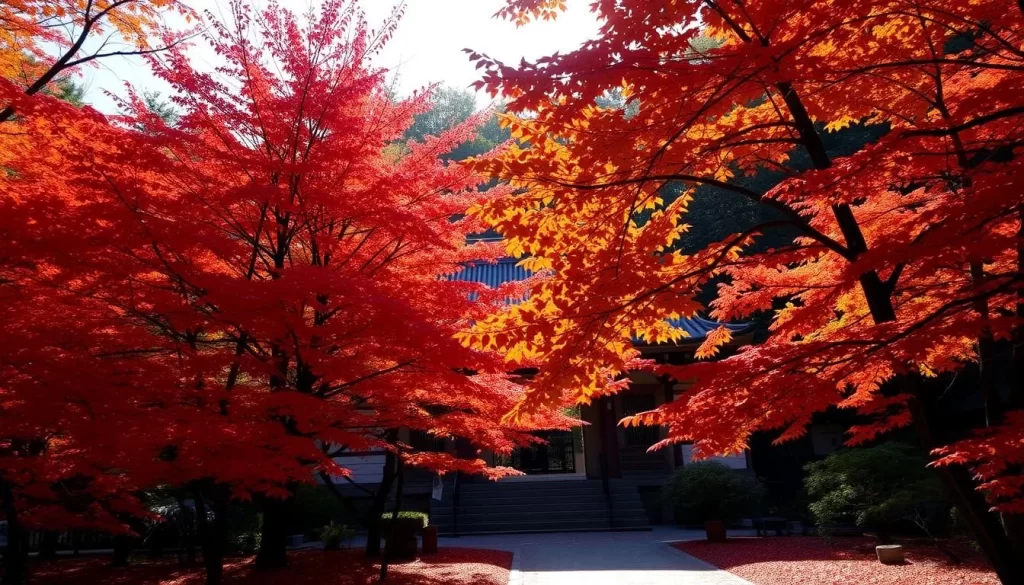
Packing Essentials for Each Season
When planning your trip to Nara, it’s crucial to pack according to the season to ensure a comfortable and enjoyable experience. The city’s climate varies significantly across the year, impacting what you should bring.
Spring and Fall Packing List
For spring and fall, pack layers for mild temperatures. Include lightweight jackets, comfortable walking shoes, and umbrellas for unexpected rain showers.
| Season | Clothing | Accessories |
|---|---|---|
| Spring/Fall | Lightweight jackets, T-shirts, jeans | Umbrellas, sunglasses, hats |
Summer Essentials
Summer in Nara can be hot and humid. Don’t forget to pack sunscreen, a hat, and light, breathable clothing to stay cool in the weather.
Winter Necessities
During winter, Nara can get quite cold with occasional snow. Bring warm clothing, including a thick coat, gloves, hats, and scarves. Sturdy, waterproof shoes are also a must for walking in potentially slippery conditions.
Conclusion
Nara’s allure is undeniable, with each season offering a unique perspective on this ancient city’s beauty. Whether you’re captivated by the cherry blossoms in spring, the vibrant autumn leaves, or the serene winter landscapes, Nara is a destination that promises an unforgettable trip.
The best time to visit Nara depends on your preferences, but late March to May and October to November are highly recommended for their mild weather and plethora of cultural events. Planning ahead is crucial, and being mindful of peak seasons like Golden Week and avoiding the sweltering summer heat can greatly enhance your experience.
Regardless of when you visit, Nara’s timeless charm and varied attractions ensure a memorable journey year-round. With its rich heritage, picturesque landscapes, and welcoming atmosphere, Nara invites you to explore its depths and return again, wiser and more enchanted.
The above is subject to change.
Check back often to TRAVEL.COM for the latest travel tips and deals.
